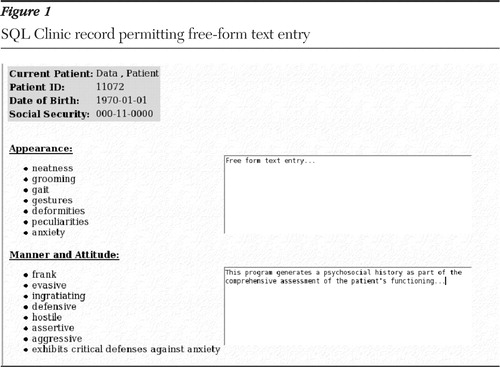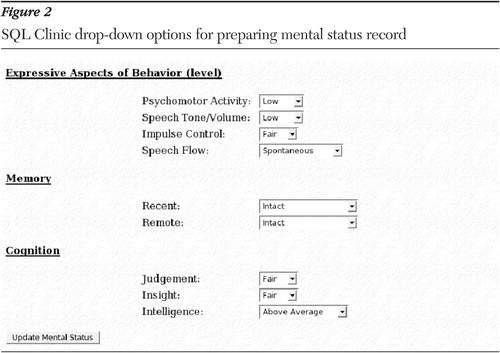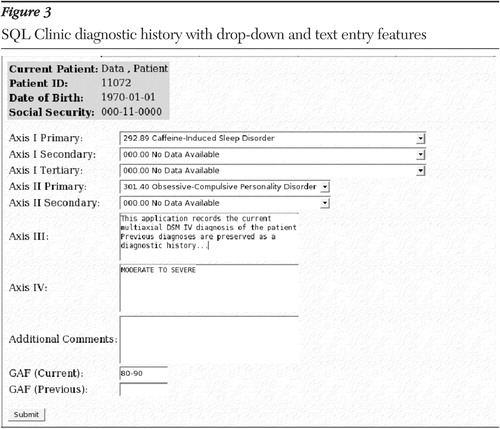Clinical Computing: SQL Clinic: The Open-Source Alternative for Electronic Medical Records
Introduction by the column editors: Open-source software addresses three crucial needs of users: it is easy to customize, it is inexpensive, and the user's future is not tied to that of a vendor company. Although the software the authors describe in this month's column is still too formidable for an individual practitioner, moderate-sized organizations should consider it near the top of the list. Let us hope that programmers develop a version tailored for solo and small group practices soon. We will report on it in this column when it occurs.
Although a number of open-source electronic medical records exist for medical providers, few applications exist for psychiatry. In 2001 a new application called SQL Clinic, an open-source application that provides an alternative to proprietary applications, was released to address this deficit. The goal of this column is to educate the reader about open source as well as SQL Clinic.
Open source
The open-source movement began in the early 1980s with the premise that computer source code should be free for programmers to use and modify. The software may be sold for a small fee, but anyone using it is free to modify it or share it with others. Typically, the original code base is developed and tested and then "released" on a Web site as open-source software (1).
The basic idea behind open source is that when programmers can read, redistribute, and modify the source code for a piece of software, the software evolves. People improve it, adapt it, and fix bugs, thus creating a better product than the traditional closed, or proprietary, model.
Open-source operating systems, such as Linux, as well as numerous applications, databases, and software are freely available. A majority are released under the GPL (general public license) that prohibits making any derivative works proprietary (2).
SQL Clinic
SQL Clinic is an open-source software project of the department of residential services of behavioral health services at Saint Vincent's Catholic Medical Centers. The SQL portion of the name refers to "structured query language," which is the interface language for relational databases.
SQL Clinic is an electronic medical record designed for mental health providers who treat persons with severe and persistent mental illness or persons with mental illness and chemical abuse histories. It is most useful to agencies providing housing, case management, and substance abuse services; however, is easily adaptable to other behavioral health services (for example, inpatient, day treatment, and outpatient) as well as to private practice.
Design philosophy
SQL Clinic is a Web application written in Perl, which works easily with many other computer languages. SQL Clinic was designed to be customized by providers with modest skills in Perl and database design. SQL Clinic has an interface that is similar to that of the Web browser used to access the Internet. Large text entry fields accommodate free form text entry (Figure 1). Whenever possible, drop-down menus are used to reduce redundant typing and ensure data integrity. Figure 2 illustrates the use of drop-down menus in preparing a mental status examination.
Features
SQL Clinic offers a wide array of clinical and administrative features. The program can generate e-mail alerts automatically. For example, progress notes can be scanned on entry for user-defined keywords. If a search term is found, such as "suicidal," an emergency e-mail message is automatically sent to a user-defined mailing list—for example, to the medical director. Administrative features include a wide variety of applications that promote internal communication, such as custom mailing lists and a policy and procedure manual. A human resources component tracks formal supervision and staff training as well as time and attendance.
The clinical module includes referral tracking, complete demographic characteristics, including photo identification, medication, and diagnostic history (Figure 3), as well as progress notes and treatment planning. Elements of quality improvement include customer satisfaction surveys and incident tracking, as well as a wide array of quality-assurance reports. One particularly useful report is a detailed chart deficiency review. Internal user authentication with the Web browser is complemented by a hierarchy of clearance levels and logging of all document access or modification.
History and background
In 1997 the department of residential services at Saint Vincent's Catholic Medical Centers began to develop a prototypical database application, built with open-source tools, to provide a low-cost, reliable information management solution for nonprofit health care providers. On July 1, 1999, after two years of development, residential services at Saint Vincent's Catholic Medical Centers deployed the application internally.
In late 2001, after the reliability and functionality of the prototype application had been proven, it was decided to create a new application on the basis of what had been learned and what had been offered as suggestions and criticisms from our user base. The development team was expanded into an international group of programmers with varying specialties, and SQL Clinic was written from the ground up as a modern Web-based application that was built on the same open-source tools as its predecessor.
In January 2002, the first nonbeta version, SQL Clinic 1.0.0, was released for download through the SQL Clinic Web site (3). It received a warm reception from Linux Medical News and was described as an "impressive application." At the same time, technical support packages were made available for providers wishing to install and use SQL Clinic.
Support is geared toward fostering independence, because the long-range goal is to create an interagency development group that consists of providers and programmers who collaborate on development and support as the user base expands. Each "customer" may in turn become a vendor if he or she is so inclined. In this manner, SQL Clinic's development model is complemented by a congruent business model: revenue that funds development is generated not by charging for software but by charging for technical support. Four agencies have implemented or are in the process of implementing SQL Clinic with use of the technical support packages offered by Saint Vincent's Catholic Medical Centers.
Proprietary or free software
In deciding whether to use SQL Clinic or a proprietary application, several factors should be considered. Financially, the proprietary application is initially much more costly than open source. Beyond the cost of the software, a majority of proprietary software requires state-of-the-art hardware and software on clinicians' workstations. SQL Clinic is free through download (3) and can be accessed by any workstation capable of running a relatively recent Web browser, including Linux workstations.
The principal rationale offered for taking the proprietary route is commercial technical support and stability of the vendor. It is our impression, however, that commercial vendors fail or discontinue software products—for example, as a result of mergers—at least as often as their open-source counterparts. The quality of the technical support is also important. We have found that most often in-house support is superior to support from a vendor, in terms of both response time and willingness to customize features. Indeed, as most large agencies using proprietary applications require an in-house database administrator anyway, it seems prudent to hire an administrator with a background in the computer language in which the application is written.
Prerequisites
To implement SQL Clinic, a server running either Linux (4), FreeBSD (5), or Windows XP is required, as is a computer network infrastructure: a server; workstations; hubs; routers; telecommunications equipment, such as modems, and telephone lines, if necessary; and a local area network mail server or POP or SMTP through an Internet provider if the e-mail capabilities of SQL Clinic are to be used. In addition, a Web browser is required; each workstation will need to run FireFox, Mozilla, or Netscape. Internet Explorer may be used; however, it is missing security features available in other browsers.
Finally, an information technology person to maintain the network and perform database administration is necessary. For large agencies, it may be cost-effective to hire a full-time information technology staff member. However, for private practitioners or small agencies, it might be more affordable to hire an outside consultant to troubleshoot on an as-needed basis.
The future of SQL Clinic
The SQL Clinic development model has been effectively used by other programmers in other clinical settings. In 2002 a new project, the SQL Care electronic medical records base package, emerged, which is based on the SQL Clinic philosophy but reflects the needs of the developer, a Canadian optometrist. SQL Care is a base package that developers can use as a springboard for developing specialty specific modules.
For example, Saint Vincent's Catholic Medical Centers, in collaboration with CODAC Behavioral Healthcare of Rhode Island, used the SQL Care base package to develop the SQL Care::Open Door module. SQL Care::Open Door is an electronic medical records module for providers of substance abuse treatment, education, and prevention services. Similar to SQL Clinic, SQL Care::Open Door provides a variety of clinical and administrative features. In April 2004 the first stable version of Open Door was released. This first version has proven reliable and is now being enhanced. Future versions will include a billing module that generates both Centers for Medicare & Medicaid Services 1500 claims forms and American National Standards Institute (ANSI) X12 837P/I electronic claims. A dosing module to dispense liquid medicine from an electronically controlled pump is also in development. For information on SQL Care::Open Door, visit the Web site at opendoor.sqlcare.net. Additional modules addressing the needs of practitioners in various settings (private practice and small clinics) and various specialties are also under way—for example, midwifery and optometry.
Mr. Good and Ms. DiTommaso are affiliated with the residential services and ambulatory chemical dependency services at Saint Vincent's Catholic Medical Centers, 75 Vanderbilt Avenue, Quarters 8, Staten Island, New York 10304. Send correspondence to Ms. DiTommaso (e-mail, [email protected]). Joshua Freedman, M.D., and Richard N. Rosenthal, M.D., are editors of this column.

Figure 1. SQL Clinic record permitting free-form text entry

Figure 2. SQL Clinic drop-down options for preparing mental status record

Figure 3. SQL Clinic diagnostic history with drop-down and text entry features
1. Open Source Initiative. Available at www.opensource.org/index.htmlGoogle Scholar
2. Pedhazur H, McClure S: Open Source Software, Aug 1999 (International Data Corp Bulletin no 20068). Available at www.opticality.com/Press/Opticality/IDC20068.htmGoogle Scholar
3 SQL Clinic. Available at www.sqlclinic.netGoogle Scholar
4. Slackware Linux Project. Available at www.slackware.comGoogle Scholar
5. FreeBSD, Available at www.freebsd.orgGoogle Scholar



